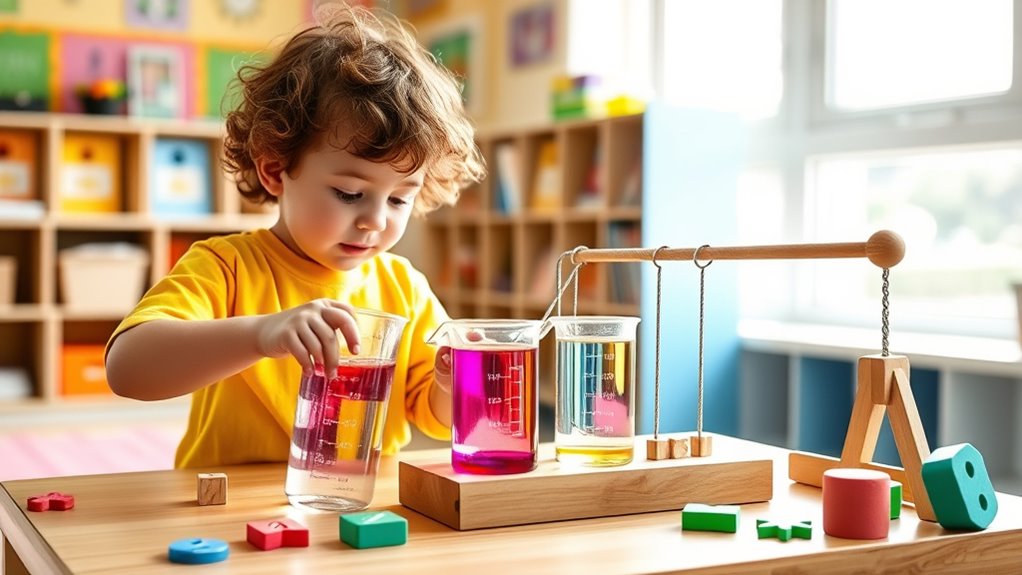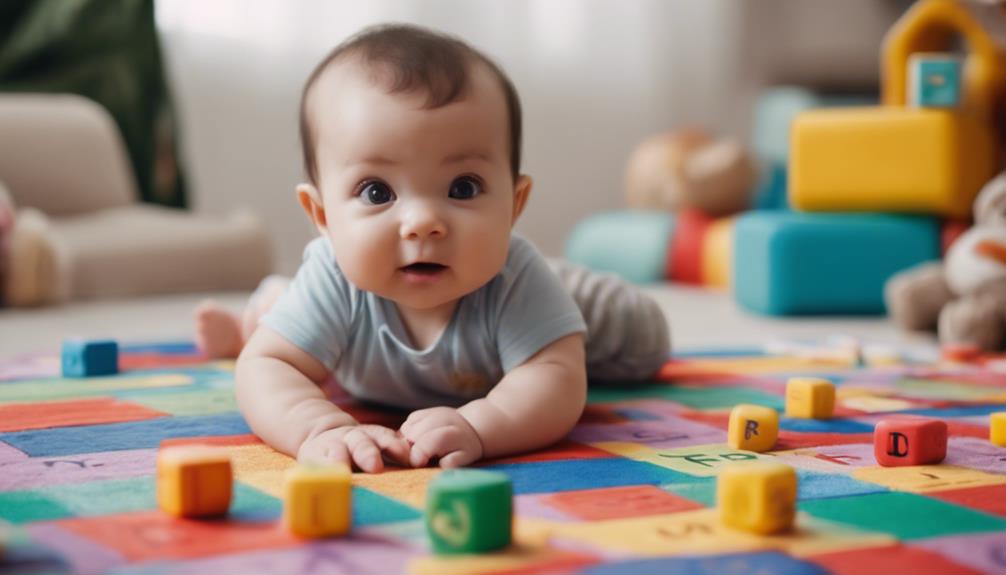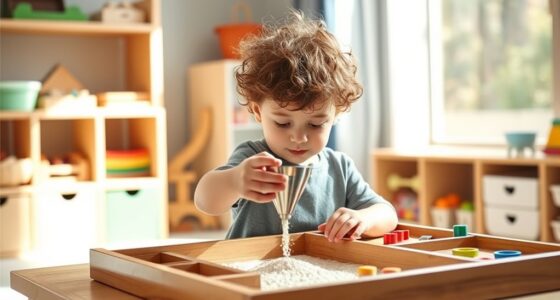To spark your toddler’s curiosity, try simple STEM activities like exploring colors and mixing paints to see how new shades form, building with blocks to understand shapes and balance, and playing with water to learn about volume and flow. These hands-on activities boost fine motor skills, encourage experimentation, and promote early math and science understanding. Keep experimenting and observing — there’s plenty more fun ways to support your child’s growth in STEM skills ahead.
Key Takeaways
- Use colorful objects and primary paints to teach color recognition and mixing through hands-on experiments.
- Build with blocks of different shapes and sizes to develop shape awareness and balance skills.
- Incorporate water play with cups and bottles to explore volume, flow, and measurement concepts.
- Engage toddlers in stacking and balancing activities to promote spatial awareness and fine motor development.
- Incorporate sensory-rich activities like water and color mixing to make science and math concepts engaging and fun.
Exploring Colors and Mixing to Discover New Shades
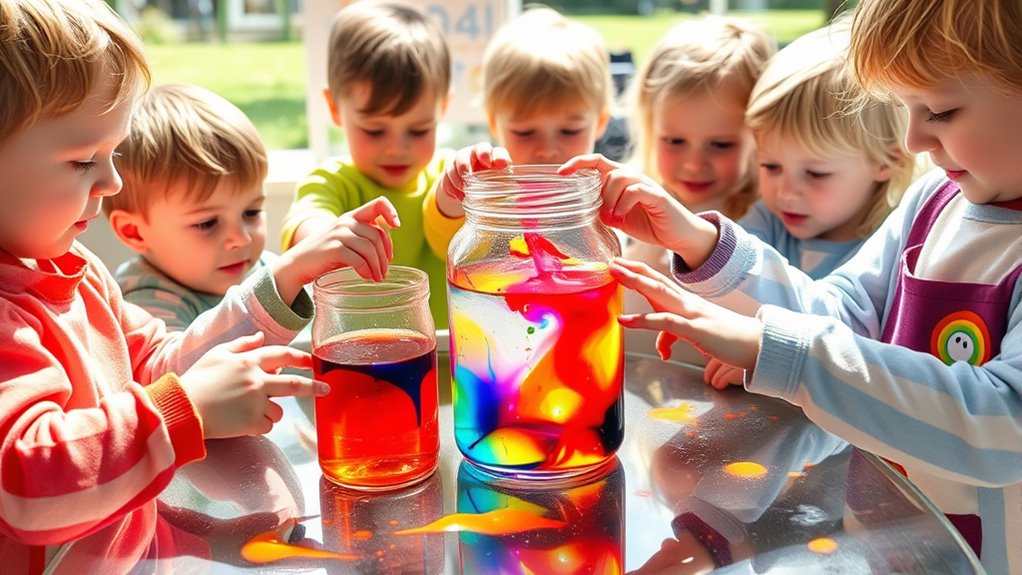
Introducing colors to your toddler can be an exciting way to boost their curiosity and sensory development. Start by helping them with color identification—point out bright hues and name them clearly. Use simple activities like showing red, blue, and yellow objects, encouraging your child to recognize and name each shade. Then, introduce shade mixing by offering primary-colored paints or liquids. Let your toddler experiment by combining these colors in small cups or on paper, observing how they create new shades. This hands-on approach helps develop their understanding of color relationships and enhances fine motor skills. Incorporate visual learning tools such as colorful pictures or flashcards to reinforce color recognition. Using age-appropriate materials ensures the activities are safe and engaging for your preschooler. Additionally, discussing the science of color mixing can deepen their understanding of how different shades are formed. Understanding the impact of colors on emotions can also enrich their appreciation for art and self-expression. Keep the activities playful and engaging, guiding them gently through the process without rushing. Your child’s ability to identify colors and explore shade mixing will grow naturally through these fun, sensory-rich experiences.
Building With Blocks to Understand Shapes and Balance
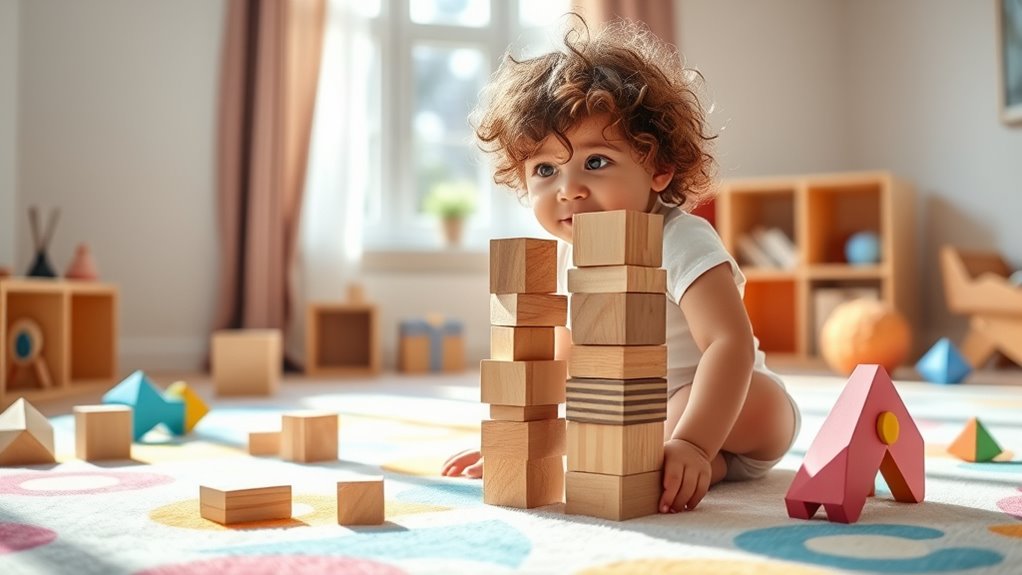
Building with blocks provides a hands-on way for your toddler to learn about shapes and balance. As they stack and arrange, they develop spatial awareness by understanding how different shapes fit together and how objects relate in space. This activity also sharpens their fine motor skills, as grasping, placing, and balancing blocks require precision and control. Encourage your child to experiment with balancing blocks of various sizes and shapes, which helps them grasp concepts of stability and weight distribution. By exploring how to build taller towers or more complex structures, they learn about cause and effect while enhancing their problem-solving abilities. Building with blocks is a simple, engaging way to support your toddler’s cognitive and motor development through playful exploration.
Water Play Activities to Learn About Volume and Flow
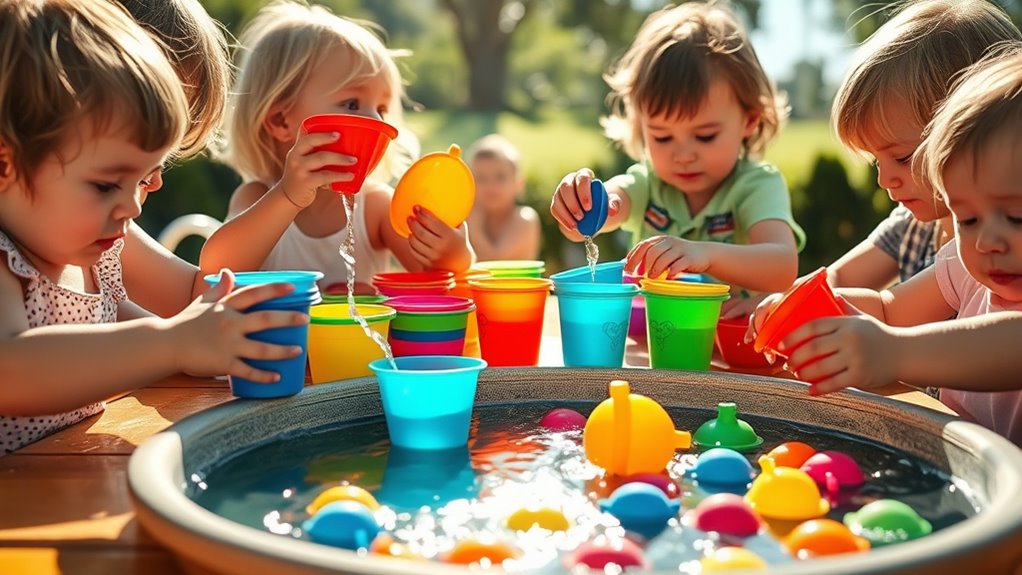
Playing with water offers a dynamic way for toddlers to explore fundamental science concepts like volume and flow. Set up simple activities where they can measure liquids using cups, spoons, or bottles, helping them understand different amounts and how liquids move. Encourage them to pour water from one container to another, observing how flow changes with container shape and size. These activities promote early math skills and introduce water conservation—teaching kids to be mindful of how much water they use. You can also discuss why saving water is important while they play, fostering awareness of resource management. Through hands-on water play, toddlers develop fine motor skills, learn about measurement, and gain a basic understanding of sustainable habits in a fun, engaging way. Understanding water conservation helps instill lifelong values about resourcefulness and environmental care.
Frequently Asked Questions
How Can I Adapt STEM Activities for Different Developmental Stages?
When adapting activities for different developmental stages, you focus on making age-appropriate modifications. You can introduce more complex concepts for older children while simplifying tasks for younger ones. Consider developmental adaptations like varying the difficulty level, using different tools, or adding visual supports. By observing their responses and progress, you guarantee each child engages meaningfully, fostering curiosity and learning at their unique developmental stage.
What Safety Precautions Should I Take During Science Experiments With Toddlers?
When conducting science experiments with toddlers, prioritize safety by implementing hazard prevention measures. Make certain activities include age-appropriate challenges, so they’re engaging but safe. Always supervise closely, keep dangerous materials out of reach, and use child-friendly, non-toxic supplies. Check for potential hazards beforehand, like sharp objects or choking risks. By maintaining a safe environment, you help kids explore confidently while minimizing accidents and ensuring a fun learning experience.
Are There Any Recommended Materials for Toddler-Friendly STEM Activities?
When choosing materials for toddler-friendly STEM activities, you should look for recyclable materials and natural objects that are safe and easy for little hands to handle. Items like plastic bottles, cardboard, leaves, and stones are perfect. These materials encourage curiosity and exploration while being eco-friendly. Always guarantee the objects are clean, free of sharp edges, and age-appropriate to keep your toddler safe during play and learning.
How Can I Encourage Toddlers’ Curiosity During STEM Play?
To encourage your toddler’s curiosity during STEM play, focus on sensory exploration and question prompting. Offer varied materials to stimulate their senses, like textured objects or colorful items. Ask open-ended questions, such as “What do you notice?” or “Why do you think that happens?” This approach keeps them engaged, sparks their natural curiosity, and helps them develop critical thinking skills through hands-on discovery and thoughtful conversation.
How Much Supervision Is Appropriate for Toddlers During These Activities?
Think of supervision levels like a gentle lighthouse guiding a ship—firm yet flexible. You should closely watch your toddler during activities, especially with small objects or liquids, to guarantee safety. Follow safety guidelines by keeping a watchful eye without micromanaging, allowing independence to grow. Always stay within arm’s reach, ready to assist or intervene if needed, ensuring their exploration remains safe and fun.
Conclusion
As you guide your little one through these playful activities, you’re gently nurturing their curiosity and understanding of the world around them. Each colorful experiment, block build, or water adventure becomes a quiet invitation for discovery, fostering a love for learning that blossoms naturally over time. Remember, you’re not just teaching concepts—you’re opening doors to endless wonder, helping them see that every moment of exploration is a precious step on their journey of growth.

